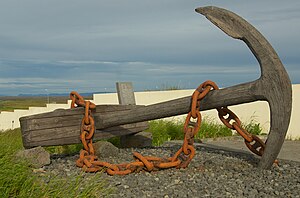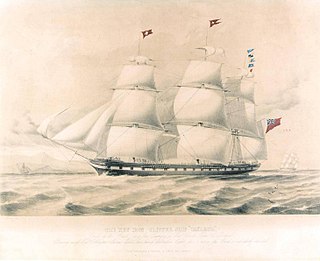
RMS Tayleur was a full-rigged iron clipper ship chartered by the White Star Line. She was large, fast and technically advanced. She ran aground off Lambay Island and sank, on her maiden voyage, in 1854. Of more than 650 aboard, only 280 survived. She has been described as "the first Titanic".

Marco Polo was a three-masted wooden clipper ship, launched in 1851 at Saint John, New Brunswick. She was named after Venetian traveler Marco Polo. The ship carried emigrants and passengers to Australia and was the first vessel to make the round trip from Liverpool in under six months. Later in her career, the ship was used as a cargo ship before running aground off Cavendish, Prince Edward Island, in 1883.

Boon Island is a barren, rocky island in the Gulf of Maine 6 mi (9.7 km) off the coast of York, Maine, United States. The island, which is approximately 300 ft (91 m) by 700 ft (210 m) at low tide, is the site of Boon Island Light, at 137 ft (42 m) high, it is the tallest lighthouse in New England. Numerous vessels have been wrecked on its rocky shoreline. John Winthrop, the English Puritan lawyer and one of the leading figures in founding the Massachusetts Bay Colony, mentions passing Boon Island in the 1600s.

The Carroll A. Deering was an American five-masted commercial schooner launched in 1919 and found run aground without its crew off Cape Hatteras, North Carolina, in January 1921.

SS Valencia was an iron-hulled passenger steamer built for the Red D Line for service between Venezuela and New York City. She was built in 1882 by William Cramp and Sons, one year after the construction of her sister ship Caracas. She was a 1,598-ton vessel, 252 feet (77 m) in length. In 1897, Valencia was deliberately attacked by the Spanish cruiser Reina Mercedes off Guantanamo Bay, Cuba. The next year, she became a coastal passenger liner on the U.S. West Coast and served periodically in the Spanish–American War as a troopship to the Philippines. Valencia was wrecked off Cape Beale, which is near Clo-oose, on the west coast of Vancouver Island, British Columbia, on 22 January 1906. As her sinking killed 100 people, some classify the wreck of Valencia as the worst maritime disaster in the "Graveyard of the Pacific", a famously treacherous area off the southwest coast of Vancouver Island.
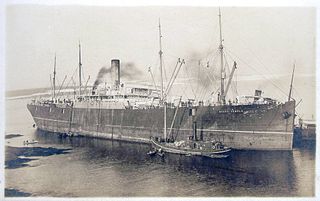
Mount Temple was a passenger cargo steamship built in 1901 by Armstrong Whitworth & Company of Newcastle for Elder, Dempster & Co Ltd of Liverpool to operate as part of its Beaver Line. The ship was shortly afterwards acquired by the Canadian Pacific Railway. It was one of the first vessels to respond to the distress signals of RMS Titanic in 1912.
MV Vikartindur was a German registered 8,633 ton container ship that became stranded on a beach on the south coast of Iceland on March 5, 1997, while en route from Tórshavn, the capital of the Faroe Islands, to Reykjavík.
The Tek Sing was a large three-masted Chinese ocean-going junk which sank on 6 February 1822, in an area of the South China Sea known as the Belvidere Shoals. The vessel was 50 meters in length, 10 meters wide and had a burden of about a thousand tons. Its tallest mast was estimated to be 90 feet (27 m) in height. The ship was manned by a crew of 200 and carried approximately 1,600 passengers. The great loss of life associated with the sinking has led to the Tek Sing being referred to in modern times as the "Titanic of the East". It is one of the few "Asian vessels discovered in Southeast Asia [whose name is known]"; generally, neither the name nor the date is known. The Tek Sing is an exception." Generally, shipwrecks are named either after a landmark or location near which they or the cargo they held were found.

SS Washingtonian was a cargo ship launched in 1913 by the Maryland Steel Company of Sparrows Point, Maryland, near Baltimore, as one of eight sister ships for the American-Hawaiian Steamship Company. At the time of her launch, she was the largest cargo ship under American registry. During the United States occupation of Veracruz in April 1914, Washingtonian was chartered by the United States Department of the Navy for service as a non-commissioned refrigerated supply ship for the U.S. fleet stationed off the Mexican coast.

SS Ferret was an iron screw steamship of 460 tons built in Glasgow (Scotland) in 1871 by J & G Thomson, Glasgow.
SS United States was a merchant steamship launched in 1864 and lost off Cape Romain, South Carolina, in 1881. She was the most expensive steamer built by the American shipbuilding firm of S. Gildersleeve & Son, which built 120 vessels. The vessel was named for her country and sported the United States' national symbol, an American eagle, as her figurehead.
The Cemfjord was a Cyprus-registered cargo ship which foundered in the Pentland Firth off the north-east coast of Scotland on 2 January 2015. Built as the general cargo ship Margareta in 1984, she was converted to carry cement in 1998 and was en route from Aalborg, Denmark to Runcorn, Cheshire, United Kingdom when she capsized in bad weather and sank in 82 metres (270 ft) of water. All eight crew were presumed lost. No bodies were recovered, and the ship has been left as a sea grave.
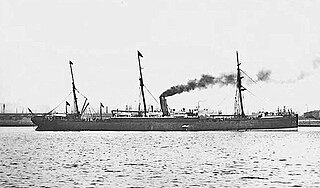
SS Catalonia was a cargo passenger vessel built in 1881 and owned by the Cunard Line.

The George Spencer was a wooden lake freighter that sank on along with her schooner barge Amboy on Lake Superior, near Thomasville, Cook County, Minnesota in the Mataafa Storm of 1905. On April 14, 1994, the wrecks of the Spencer and the Amboy were listed on the National Register of Historic Places.
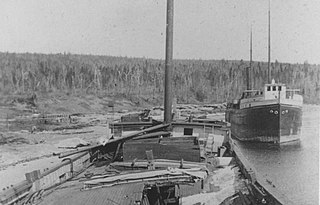
The AmboyandGeorge SpencerShipwreck Site is an archeological shipwreck site which consists of the wrecks of the wooden bulk freighter George Spencer and the wooden schooner-barge Amboy. Both vessels were wrecked during the Mataafa Storm of 1905. In 1994 the site was added to the National Register of Historic Places.

The wooden steamship Dora was a passenger and cargo vessel that served the coastal trade in the Territory of Alaska from 1880 to 1920. Built in San Francisco, California, it was active before, during and after the Klondike Gold Rush, and became known as "the bulldog of the North Pacific". After its sinking, a US Fish and Wildlife Service report referred to it as the "most historic vessel plying Alaskan waters."
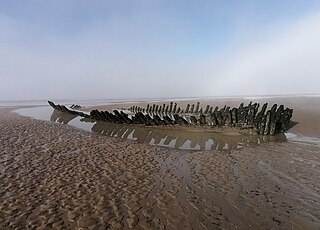
The Nornen was a large sailing vessel of the barque type. The three masts were typical of barque ships; the foremast and mainmast square-rigged and the mizzenmast (stern) rigged fore-and-aft. The main mast could be rigged with up to five horizontal yards.
